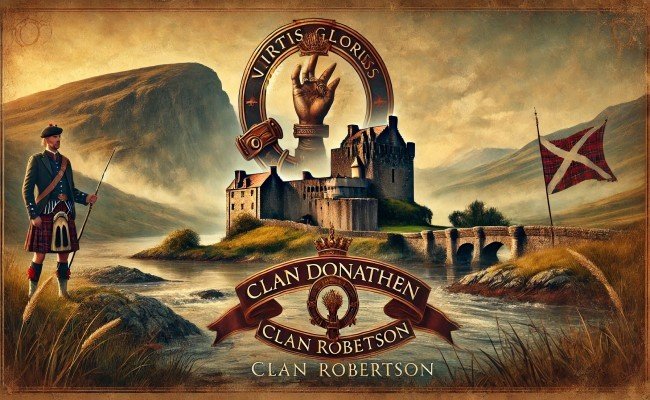The intricate tapestry of Scottish clans is woven with stories of loyalty, fierce independence, and deep-rooted traditions. Among these proud lineages, Clan Donathen and Clan Roberson stand as distinguished examples of Scotland’s storied past. Both clans have contributed significantly to the culture, heritage, and military prowess that define Scottish identity. This article will explore the histories of these two clans, their significance in Scotland, their connections to key events, and their roles in shaping the present.
Clan Donathen: A Brief Overview
The origins of Clan Donathen are steeped in mystery and legend. Like many clans in Scotland, its beginnings are difficult to pinpoint, but oral traditions suggest the clan emerged in the northern Highlands. Some historical documents hint at a relationship between Clan Donathen and the powerful MacDonachie line, though there are still debates regarding the authenticity of this connection.
This resilience was a hallmark of their identity, enabling them to persist through Scotland’s tumultuous history, including periods of intense clan rivalry and English intervention.
In times of peace, the Donathen clan thrived as farmers, using their lands to cultivate a modest but sustainable lifestyle. However, their strategic location often placed them in the path of conflict, particularly during the Jacobite uprisings of the 18th century.
The History of Clan Roberson
Clan Roberson (often referred to as Clan Robertson or Clan Donnachaidh) has a more clearly defined historical path. One of the most significant clans in Scottish history, Clan Roberson traces its lineage back to the early medieval period and takes its name from Robert Riach, a leader who gained prominence during the Wars of Scottish Independence.
Robert Riach’s descendants would go on to form one of Scotland’s most loyal and stalwart clans. Clan Roberson’s loyalty to the Scottish crown became a defining characteristic that continued through generations.
The clan’s motto, “Virtutis Gloria Merces” (“Glory is the Reward of Valor”), reflects their warrior heritage, but they were also key players in politics and diplomacy during the more peaceful periods of Scottish history. The Roberson family played prominent roles in local governance, managing the lands they controlled and working to ensure the welfare of their community.
Clan Donathen and Clan Roberson: Cultural Significance
The cultural traditions of Clan Donathen and Clan Roberson reflect the richness of Scottish heritage. While distinct in many ways, both clans shared core values such as loyalty, courage, and pride in their ancestral lands.
For Clan Donathen, their isolation in the Highlands fostered a culture of self-reliance and tight-knit familial ties. Oral storytelling was a key part of their culture, passing down legends and family history from generation to generation. Clansmen took pride in their independence, defending their lands from any who sought to encroach upon them. Music, especially bagpipes, and traditional Highland dress played vital roles in ceremonial events, reinforcing their connection to the land and their ancestors.
In contrast, Clan Roberson had a more outward-facing culture, largely due to their engagement in major political and military events in Scottish history. The clan’s participation in significant battles and its close connection to Scottish royalty meant they were often in the public eye. Yet, they too held fast to traditional Scottish values and customs.
The Role of Clan Donathen and Clan Roberson in the Jacobite Uprisings
The Jacobite uprisings of the 17th and 18th centuries were a pivotal period for many Scottish clans, including Clan Donathen and Clan Roberson.
Clan Roberson, with its history of loyalty to the Scottish crown, was one of the leading clans in the Jacobite rebellions. They were staunch supporters of the Stuart claim to the throne, participating actively in both the 1715 and 1745 uprisings. The Roberson chief at the time, Alexander Robertson of Struan, fought valiantly for the Jacobites, even as their cause ultimately ended in defeat.
Their knowledge of the terrain in the Highlands and guerrilla warfare tactics made them invaluable allies to the Jacobite cause. Many Donathen men faced harsh consequences following the failed rebellions, as the British government sought to pacify the Highlands by dismantling the power of the clans.
Clan Donathen and Clan Roberson in Modern Times
Annual clan gatherings, Highland games, and other cultural events bring together descendants from around the world, fostering a strong sense of community and pride in their heritage.
Clan Roberson remains particularly active in Scotland, with many families tracing their lineage back to the original clansmen who fought in Scotland’s pivotal battles. The Clan Donnachaidh Society, which represents Clan Roberson and its various branches, remains a strong presence, preserving the history, traditions, and culture of the clan. Clan Donathen, while less well-known, continues to have a dedicated following among those who proudly carry its name and heritage.
The Tartan and Symbols of Clan Donathen and Clan Roberson
This tartan features rich hues of green and brown, symbolizing the natural beauty of the Scottish Highlands where the clan originated.
Clan Roberson (Donnachaidh), on the other hand, boasts a more prominent and widely recognized tartan. The crest of Clan Roberson features a hand holding an imperial crown, symbolizing the clan’s loyalty to the Scottish crown, while their motto reinforces their valorous heritage.
Clan Donathen Clan Roberson: Preserving Heritage for Future Generations
As Scotland continues to embrace its rich history, Clan Donathen and Clan Roberson stand as enduring symbols of the strength, loyalty, and resilience that define the Scottish people. Through events like clan reunions, Highland games, and tartan celebrations, modern descendants ensure that the proud legacies of these two clans remain alive and thriving.
For those with roots in Clan Donathen or Clan Roberson, learning about their history, traditions, and values offers a deeper connection to their Scottish ancestry. Whether through genealogical research, participation in cultural events, or simply wearing the clan tartan, these proud Scots continue to honor the memory of their forebears.
Conclusion
The legacies of Clan Donathen and Clan Roberson are rich with history, valor, and pride. Though they come from different regions and backgrounds, both clans exemplify the resilience and loyalty that define Scotland’s clans. By preserving their stories, tartans, and traditions, modern descendants of these clans keep alive a proud and vibrant heritage that continues to inspire Scots and people of Scottish descent worldwide. Whether you’re a historian, a genealogist, or simply someone with a love for Scottish culture, the stories of Clan Donathen and Clan Roberson offer a fascinating glimpse into Scotland’s past.
Clan Donathen Clan Roberson FAQs
Where did Clan Donathen originate?
Clan Donathen originated in the northern Highlands of Scotland, where its members were known for their warrior skills and guerrilla warfare tactics. Their remote location helped them maintain a strong sense of independence.
What is the motto of Clan Roberson?
The motto of Clan Roberson is “Virtutis Gloria Merces,” which means “Glory is the Reward of Valor.” This reflects the clan’s proud warrior heritage and dedication to courage and loyalty.
Did Clan Donathen participate in the Jacobite uprisings?
Yes, although they played a lesser-known role, members of Clan Donathen are believed to have supported the Jacobite cause, using their knowledge of the Highlands to assist in guerrilla warfare tactics during the uprisings.
What is the connection between Clan Roberson and Robert the Bruce?
Clan Roberson has strong historical ties to Robert the Bruce, particularly through their support during the Wars of Scottish Independence. Clan members fought alongside Robert the Bruce at the Battle of Bannockburn in 1314.
How is Clan Donathen remembered today?
Though not as well-known as some other clans, Clan Donathen is remembered for its resilience and independence. Descendants continue to honor their heritage through participation in cultural events like Highland games and clan gatherings.
What is the tartan of Clan Roberson?
The tartan of Clan Roberson is a distinctive pattern featuring red, green, and black checks. It is widely recognized and worn by clan members at formal events and cultural celebrations.











